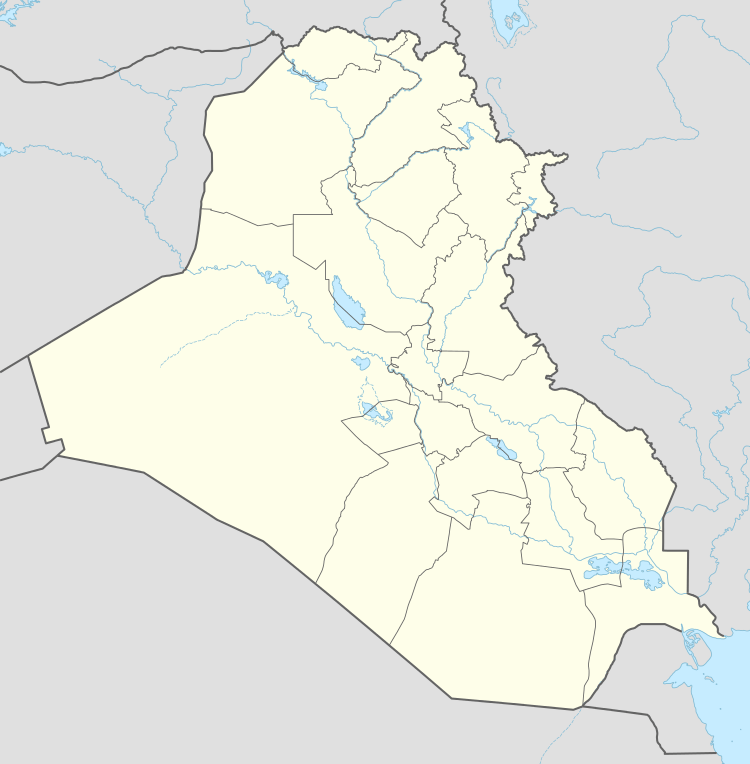Safwan Airfield standoff
| Safwan Airfield standoff | |||||
|---|---|---|---|---|---|
| Part of the Gulf War (aftermath) | |||||
 Safwan Safwan (Iraq) | |||||
| |||||
| Belligerents | |||||
|
|
| ||||
| Commanders and leaders | |||||
|
|
| ||||
| Casualties and losses | |||||
| None | |||||
The Safwan Airfield standoff was a post-ceasefire standoff between the Iraqi and U.S. forces at the end of the 1991 Gulf War.
Background
After the ground offensive, General Herbert Norman Schwarzkopf, Jr. of the coalition forces wanted a spot deep in Iraq to discuss the capitulation terms. He chose Safwan Airfield in southern Iraq to hold a formal cease-fire ceremony, as a demonstration that the coalition was in control of the war. The airfield had been supposedly seized by VII Corps some hours earlier. However Safwan had not been taken by US troops as he had assumed. This caused General Schwarzkopf to become enraged at General Frederick M. Franks, Jr., and ordered him to take the town immediately, as he was determined to use it for the incoming talks as scheduled.
On the morning of March 1, 1991, M1A1 Abrams and M3A2 Bradleys from VII corps arrived at Safwan Airfield to find a group of Iraqi T-72s defending the base and the adjoining village. VII Corps gave them the option of fighting and being destroyed or vacating the place. The entire Iraqi garrison left the site at dusk, and the coalition forces quickly moved in.
Standoff
Before the truce, the 1st Infantry Division had received orders to secure the road junction at Safwan. However, because of a miscommunication and a false report of friendly artillery fire, the 1st Infantry Division fell short of its target by ten miles. As result, LTC Wilson, the 1/4 Cavalry commander, scrambled his troops with orders to secure Safwan by 1600 of March 1. Meanwhile, General Franks assumed full responsibility for the mishap.[1]
All troops of the squadron were alerted to move out at 0615 and head north. Above them, OH-58 Kiowa Warrior scout and AH-1 Cobra attack helicopters acted as guides. The lead units of the 1/4 Cavalry reached the airfield about an hour later. They were surprised when what they saw on maps as an uncompleted highway turned out to be the Safwan airfield. At first, the area seemed to be deserted, but overhead, helicopter crews reported the dug in tanks of an entire Iraqi brigade. Pope received the order not to fire unless fired upon and to continue forward. Without firing a shot, Alpha Troop occupied the airfield under the guns of the defending Iraqis. The enemy forces Pope found turned out to be a group of demoralized, starving, and ragged Iraqis. Some Americans broke out their Meals Ready to Eat (MREs) and shared them with the Iraqi defenders. Soon after they started eating, an Iraqi colonel marched up, furious that his men accepted American food and demanding that the Americans depart. Pope informed him that it was the Iraqis who would have to leave the area. He exchanged maps with the colonel and the Iraqi retreated back to his own lines to inform his superiors.
All around the perimeter, the same type of exchange was going on with different troops and LTC Wilson himself. After a short period of time the Iraqi colonel returned to Pope’s position and told him the Iraqis were not going to leave (although many Iraqis had already abandoned their positions). As the tension increased, a flight of AH-64 Apache attack helicopters flew over. Pope reiterated the order, shouting over the thumping of the copters’ blades that the Americans would attack if the Iraqis did not move. The Iraqi colonel went back to tell his superiors. The negotiations were not moving fast enough for MG Rhame. He ordered his 2nd Brigade, under COL Tony Moreno, to Safwan. Once there, Moreno conferred with two Iraqi generals and a civilian official. He was waiting for an Iraqi answer when Rhame radioed him with orders that were direct and to the point. He told Moreno, “Tell the Iraqis to move or die.” When Moreno met the Iraqis for a second time, he cut off their reading of a prepared statement. Spitting a wad of blood at their feet (he had recently cut his lip) he said, “If you don’t leave by 16:00 hours, we will kill you.” That ended the negotiations. The Iraqis pulled out.[2]
A few days later, the Iraqis and Americans met at the airfield to sign the terms of capitulation of the Iraqi forces.
Aftermath
The incident was the result of the rigorous use of the chain of command for reports by the US General Headquarters instead of direct contact with division commanders on the ground.[3]
References
- ↑ Atkinson, Rick (1994). Crusade: The Untold Story of the Persian Gulf War. Houghton Mifflin Harcourt, pp. 6-7. ISBN 0-395-71083-9
- ↑ Incident at Safwan, by Stephen A. Bourque
- ↑ Swain, Richard M. (1999). Lucky War: Third Army in Desert Storm. DIANE Publishing, pp. 299-300. ISBN 0-7881-7865-2
Coordinates: 30°6′53″N 47°43′5″E / 30.11472°N 47.71806°E